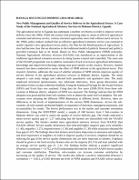| dc.description.abstract | BANAGA MUCUNGUZI DOMINIC (2014-M102-20012)
New Public Management and Quality of Service Delivery in the Agricultural Sector: A Case Study of the National Agricultural Advisory Services in Mukono District, Uganda
The agricultural sector in Uganda has undergone a number of reforms in order to improve service delivery since the 1980s. While the country took promising steps to create an effective agricultural extension and advisory service, various extension approaches were tried without much success. In the 1990s, policy makers realised that an effective agricultural extension service was essential to realise Uganda’s new agricultural sector policy, the Plan for the Modernization of Agriculture. It also had become clear that an alternative to the traditional model of publicly financed and publicly provided extension had to be found. Based on New Public Management (NPM) principles, National Agricultural Advisory Services (NAADS) was introduced as an improvement to the traditional agricultural extension services by being farmer-centred and controlled. The main aim of the NAADS programme was to address constraints of lack of access to agricultural information, knowledge and improved technology among rural poor farmers in the country. However, limited research has been conducted to assess the effect of NPM reforms in the agricultural sector. This research, therefore, addresses the issue of whether adoption of NPM reforms improves quality of service delivery in the agricultural advisory services in Mukono district, Uganda. The study adopted a case study design and collected both quantitative and qualitative data. The study employed structured questionnaires, key informant interviews, focus group discussions and document reviews as data collection methods. Using the Statistical Package for the Social Sciences (SPSS) and Excel data was analysed. Using data for five years (2009-2014) from three sub-counties in Mukono district, adoption of NPM was assessed. The findings indicate that the NPM adoption was good and the three sub-counties were at almost the same level of adoption. The sub-counties were adopting the different NPM dimensions at different levels. However, there are differences in the levels of implementation of the various NPM dimensions. Across the sub-counties, all sub-counties performed highly on separation of functions, managerial autonomy, and accountability for results. The lowest performance was in the market and customer orientation dimensions. Using the SERVPERF model, a sample of 248 farmers from 3 Sub-counties in Mukono district was used to assess the quality of service delivery gap. The results indicated a mean service quality gap of -1.27 indicating that the farmers are dissatisfied with the NAADS service quality. The farmers needed more agricultural advisory services from NAADS than NAADS offered. Service quality dimensions that indicated higher negative gaps were reliability (-1.40), empathy (-1.37), responsiveness (-1.36) and tangibles (-1.30) while assurance obtained the least gap of -0.9. The findings show that farmers attach more importance to assurance and empathy, and least importance to tangibles. In order to improve quality of services, emphasis should be on reducing the gap of the service quality dimensions that are more important to farmers. Emphasis should be given to the food security farmers who are the majority (91.1%) and least satisfied with an average service quality gap of -1.31. The findings further indicate a positive significant (Pearson’s correlation r = 0.762, p<0.05) relationship between the level of NAADS service quality and customer satisfaction. Therefore, sub-counties can increase customer satisfaction by increasing on the quality of service. The results also indicate a positive relationship (Pearson’s correlation r = -0.812, p>0.05) between the level of NPM adoption and NAADS service quality.
Therefore, sub-counties high on adoption of NPM offer better quality of services to farmers than those with low NPM adoption.
Key Words: New Public Management, Service Delivery, Agricultural Sector, National Agricultural Advisory Services, Mukono District | en_US |


